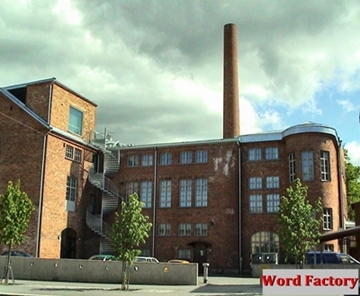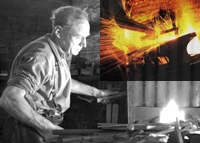

Caution: hard hats, safety glasses and construction boots required beyond this point!
This is where the final assembly gets done. From Head Office we get the raw script, the pre-production content, and we put it all together according to the specs from Standards and Forms Department. We are entirely responsible for the ultimate presentation a book will take. The script gets fixed onto pages, the pages fitted into chapters, the chapters compiled into complete volumes. We are the second last step in the process. Following us, there is only an Outside Reader with editorial rights, and, of course, the outsourced printing. But when the book leaves the shop here, it is complete and print-ready.
We are semi-automated now, with a large warehouse of prefabricated words, stock phrases, popular idiomatic expressions, a catalogue of so-called leading edge stuff. Not too many years ago, every project was handcrafted from beginning to end, the craftsman putting the stamp of his skill on every word, on every formulation. But we had to optimize, adapt to intense pressure to compete and to meet and exceed quotas. We still do custom work, but 80 percent of our activity is within the framework of templates and precast moulds. Still, we do good work and are proud of each book that goes out of here.
Of course the Head Office gets all the credit. You know, for inspiration and creativity. But we are the sweat and effort guys, the hands-on people, who actually do the work. We make sure that each word finds its place, gets properly formatted and punctuated, packaged into sections, and bound into book form. Nothing leaves the shop until Quality Assurance gets to do a final walk-through. We have to sign off, before printing, before the launch. Yeah, we are the guys behind the scene, largely unrecognized. Our reward is a book in hand and a job well done.
Down the centre of the main hall is the assembly line with all the substations feeding it. For instance, there is the 20 ton stamp machine to do bold and extrabold print. There is the articulation device to bend italics, the underline stitching machine, the punctuation extrusion, the laser burn highlighting, the font-overlays and patterning, size calibration, scaling and kerning. Oh Yes, we keep up with the times.
Now we use The Canadian Oxford dictionary exclusively for reference. We also used to cross reference with both the American Standard and traditional English lexicons, but had to downsize to stay streamlined and competitive. You should have seen the chaos in 2004 when we changed over.

Here we are in one of the adjacent workshops where specialized wordsmithing is still performed manually. You will notice the forge and anvil. The mastersmith hammers each word into semantic shape. He is able to custom fit extra nuances and connotations to individual sentence fragments. Each letter is cast, hammered and tempered. This is especially useful for idiosyncratic expressions that do not conform well to mass production. But it is an art that is going out of fashion and spell/grammar checks of word processors skip over it.
We are nearing the end. Here each page is once more scrutinized, to ensure that standards are met and exceeded, locked, encrypted or not, and sent on for shipping.
And here is the Quality Control station. Every instance of an error, weak usage and awkward formulation is documented and sent for recast. All is recorded. Here for instance, listen; “… We have again undershot the 17% mandatory guidelines for dialogue insertion. Yet exceeded by 22% the recommended allowed contractions in speech and prose descriptions. Strongly suggest rework…” As you can see, a great deal of consideration and detail goes into any project.
This was of course, just a brief overview. You are welcome to study in detail our project flowcharts, decision criteria lists, control nodes and feedback loops. The nuts and bolts of the process. Head Office gets to put its name on the book, but the actual work is done here, out of sight, completely transparent to the Reader.
Go: home